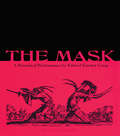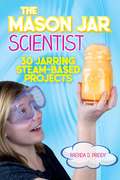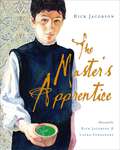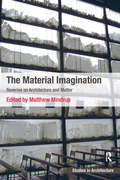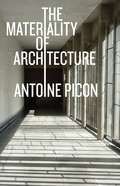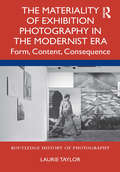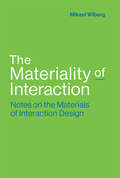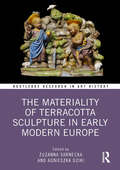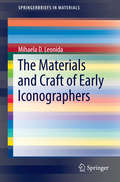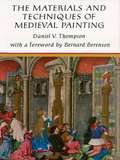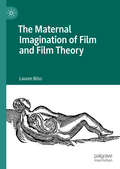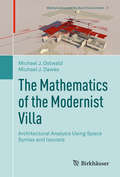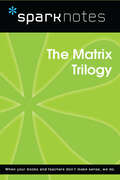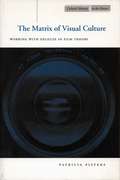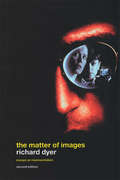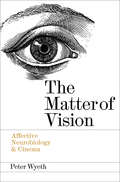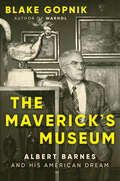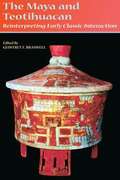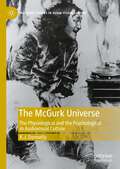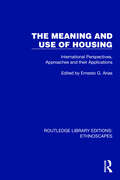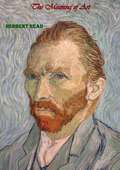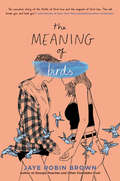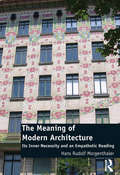- Table View
- List View
The Mask: A Periodical Performance by Edward Gordon Craig (Contemporary Theatre Studies #Vol. 30.)
by Olga TaxidouNo study of modern theater is complete without a thorough understanding of the enormous influence of visionary genius Edward Gordon Craig. Born in England in 1872, Craig went on to become famous world-wide as an actor, manager, director, playwright, designer, and most importantly an author and theorist, whose books were translated into German, Russian, Japanese, Dutch, Hungarian, and Danish. Although an essential parallel to the European avant-garde, Craig was often read as "exceptional" and highly innovative in his native Britain, thus, The Mask not only appears as Craig's main cosmopolitan project but also at times functions as a surrogate stage for his experiments in theater practice. The book has a comprehensive chronology, extensive notes and a bibliography making it an essential text for undergraduates, postgraduates, actors, theatre professionals, designers, directors, researchers and writers in the fields of theatre studies (especially theater set and lighting) and theater history.
The Mason Jar Scientist: 30 Jarring STEAM-Based Projects
by Brenda PriddyFun, STEAM-based experiments and activities to do at home—all within a mason jar! Scientific learning doesn't have to stop when kids hop off the school bus. With The Mason Jar Scientist, you and your kids can have a blast together while learning about fascinating scientific topics! This book provides dozens of practical, hands-on experiments illustrating scientific principles—that can all be done within a mason jar. Each experiment also includes discussion questions and great ideas for STEAM-based extension activities. You and your child will learn about: Clouds Why the sky is blue Tornadoes The greenhouse effect Light refraction Sound vibrations The solar system Biomes And much more! All you need for each activity is a mason jar, some household ingredients, and a desire to learn! Packed with colorful photos, clear, information, and easy-to-follow instructions, The Mason Jar Scientist is the perfect book to get kids excited about science and to spend some quality time together.
The Master's Apprentice
by Rick JacobsonWhen Marco is sent into apprenticeship with the young master, Michelangelo Buonarroti, much rides on his success. His father has worked very hard as a chemist so that Marco can have a better life, and the boy simply cannot let his family down. Armed with good advice, but more importantly, secret color formulas that his father has taught him, the boy has a good chance at success.But then he meets the jealous senior apprentice Ridolfo, and before Marco knows it, he has been tricked into looking like a fool. Time and again, the older boy trips him up, until Marco is certain he will be sent home in disgrace. When Michelangelo is summoned to Rome by the pope himself, he can only take one apprentice. Ridolfo has no intention of being left behind, but Marco knows the formula for a color Michelangelo can make good use of. When the master not only likes the gift, but demands the formula, Marco is trapped between wanting to go to Rome and betraying his father’s instruction to keep their secrets secret. In bringing this story to life, Rick Jacobson and Laura Fernandez show a little-known side of the richest artistic era in the history of the world and one of the greatest geniuses of all time.
The Material Atlantic
by Robert S. DuplessisIn this wide-ranging account, Robert DuPlessis examines globally sourced textiles that by dramatically altering consumer behaviour, helped create new economies and societies in the early modern world. This deeply researched history of cloth and clothing offers new insights into trade patterns, consumer demand and sartorial cultures that emerged across the Atlantic world between the mid-seventeenth and late-eighteenth centuries. As a result of European settlement and the construction of commercial networks stretching across much of the planet, men and women across a wide spectrum of ethnicities, social standings and occupations fashioned their garments from materials old and new, familiar and strange, and novel meanings came to be attached to different fabrics and modes of dress. The Material Atlantic illuminates crucial developments that characterised early modernity, from colonialism and slavery to economic innovation and new forms of social identity.
The Material Imagination: Reveries on Architecture and Matter (Ashgate Studies In Architecture Ser.)
by Matthew MindrupIn recent years architectural discourse has witnessed a renewed interest in materiality under the guise of such familiar tropes as 'material honesty,' 'form finding,' or 'digital materiality.' Motivated in part by the development of new materials and an increasing integration of designers in fabricating architecture, a proliferation of recent publications from both practice and academia explore the pragmatics of materiality and its role as a protagonist of architectural form. Yet, as the ethos of material pragmatism gains more popularity, theorizations about the poetic imagination of architecture continue to recede. Compared to an emphasis on the design of visual form in architectural practice, the material imagination is employed when the architect 'thinks matter, dreams in it, lives in it, or, in other words, materializes the imaginary.' As an alternative to a formal approach in architectural design, this book challenges readers to rethink the reverie of materials in architecture through an examination of historical precedent, architectural practice, literary sources, philosophical analyses and everyday experience. Focusing on matter as the premise of an architect’s imagination, each chapter identifies and graphically illustrates how material imagination defines the conceptual premises for making architecture.
The Material World of Ancient Egypt
by William H. PeckThe Material World of Ancient Egypt examines the objects and artifacts, the representations in art, and the examples of documentation that together reveal the day-to-day physical substance of life in ancient Egypt. This book investigates how people dressed, what they ate, the houses they built, the games they played, and the tools they used, among many other aspects of daily life, paying great attention to the change and development of each area within the conservative Egyptian society. More than any other ancient civilization, the ancient Egyptians have left us with a wealth of evidence about their daily lives in the form of perishable objects, from leather sandals to feather fans, detailed depictions of trades and crafts on the walls of tombs, and a wide range of documentary evidence from temple inventories to personal laundry lists. Drawing on these diverse sources and richly illustrating his account with nearly one hundred images, William H. Peck illuminates the culture of the ancient Egyptians from the standpoint of the basic materials they employed to make life possible and perhaps even enjoyable.
The Materiality of Architecture
by Antoine PiconA new paradigm combining architectural tradition with emerging technologies Digital tools have launched architecture into a dizzying new era, one in which wood, stone, metal, glass, and other traditional materials are augmented by pixels and code. In this ambitious exploration, an eminent thinker examines what, exactly, the building blocks of architecture have meant over the centuries and how technology may—or may not—be changing how we think about them. Antoine Picon argues that materiality is not only about matter and that the silence and inscrutability—the otherness—of raw materials work against humanity&’s need to live in a meaningful world. He describes how people define who they are, in part, through their specific physical experience of architectural materials and spaces. Indeed, Picon asserts, the entire paradox of the architectural discipline consists in its desire to render matter expressive to human beings. Through a retrospective review of canonical moments in Western European architecture, Picon offers an original perspective on the ways materiality has varied throughout centuries, demonstrating how experiences of the physical world have changed in relation to the evolution of human subjectivity. Ultimately, Picon concludes that computer-based design methods are not an abrupt departure from previous architectural traditions but rather a new way for architects to control material resources. The result reinforces the fundamentally humanistic nature of architectural endeavor with an increasing sense of design freedom and a release from material constraint in the digital era.
The Materiality of Exhibition Photography in the Modernist Era: Form, Content, Consequence (Routledge History of Photography)
by Laurie TaylorThis book challenges the status quo of the materiality of exhibited photographs, by considering examples from the early to mid-twentieth century, when photography’s place in the museum was not only continually questioned but also continually redefined. By taking this historical approach, Laurie Taylor demonstrates the ways in which materiality (as opposed to image) was used to privilege the exhibited photograph as either an artwork or as non-art information. Consequently, the exhibited photograph is revealed, like its vernacular cousins, to be a social object whose material form, far from being supplemental, is instead integral and essential to the generation of meaning. The book will be of interest to scholars working in art history, history of photography, theory of photography, curatorial studies and museum studies.
The Materiality of Interaction: Notes on the Materials of Interaction Design (The\mit Press Ser.)
by Mikael WibergA new approach to interaction design that moves beyond representation and metaphor to focus on the material manifestations of interaction.Smart watches, smart cars, the Internet of things, 3D printing: all signal a trend toward combining digital and analog materials in design. Interaction with these new hybrid forms is increasingly mediated through physical materials, and therefore interaction design is increasingly a material concern. In this book, Mikael Wiberg describes the shift in interaction design toward material interactions. He argues that the “material turn” in human-computer interaction has moved beyond a representation-driven paradigm, and he proposes “material-centered interaction design” as a new approach to interaction design and its materials. He calls for interaction design to abandon its narrow focus on what the computer can do and embrace a broader view of interaction design as a practice of imagining and designing interaction through material manifestations. A material-centered approach to interaction design enables a fundamental design method for working across digital, physical, and even immaterial materials in interaction design projects.Wiberg looks at the history of material configurations in computing and traces the shift from metaphors in the design of graphical user interfaces to materiality in tangible user interfaces. He examines interaction through a material lens; suggests a new method and foundation for interaction design that accepts the digital as a design material and focuses on interaction itself as the form being designed; considers design across substrates; introduces the idea of “interactive compositions”; and argues that the focus on materiality transcends any distinction between the physical and digital.
The Materiality of Terracotta Sculpture in Early Modern Europe (Routledge Research in Art History)
by Zuzanna Sarnecka Agnieszka DzikiThrough meticulously researched case studies, this book explores the materiality of terracotta sculpture in early modern Europe. Chapters present a broad geographical perspective showcasing examples of modelling, firing, painting, and gilding of clay in Portugal, Spain, Italy, Germany, and the Netherlands. The volume considers known artworks by celebrated artists, such as Luca della Robbia, Andrea del Verrocchio, Filipe Hodart, or Hans Reichle, in parallel with several lesser-studied terracotta sculptures and tin-glazed earthenware made by anonymous artisans. This book challenges arbitrary distinctions into the fine art and the applied arts, that obscured the image of artistic production in the early modern world. The centrality of clay in the creative processes of artists working with two- and three-dimensional artefacts comes to the fore. The role of terracotta figures in religious practices, as well as processes of material substitutions or mimesis, confirm the medium’s significance for European visual and material culture in general. This book will be of interest to scholars working in art history, Renaissance studies, and material culture.
The Materials and Craft of Early Iconographers
by Mihaela D. LeonidaThis book describes in detail the materials and techniques used by medieval iconographers. It offers information about the natural sources, the raw materials, the tools and the technologies involved in preparing them. The book allows entry into the secretive world of very knowledgeable and skilled artisans, about which very little is known. Topics covered include raw materials, pigments, binders, solvents, adhesives, inks and varnishes. Special chapters will be dedicated to the fresco technique as practiced by the early iconographers, grinding, painting on glass and the training/apprenticeship of these craftsmen.
The Materials and Techniques of Medieval Painting (Dover Art Instruction)
by Daniel V. ThompsonMedieval painters built up a tremendous range of technical resources for obtaining brilliance and permanence. In this volume, an internationally known authority on medieval paint technology describes these often jealously guarded recipes, lists of materials, and processes. Based upon years of study of medieval manuscripts and enlarged by laboratory analysis of medieval paintings, this book discusses carriers and grounds, binding media, pigments, coloring materials, and metals used in painting. It describes the surfaces that the medieval artist painted upon, detailing their preparation. It analyzes binding media, discussing relative merits of glair versus gums, oil glazes, and other matters. It tells how the masters obtained their colors, how they processed them, and how they applied them. It tells how metals were prepared for use in painting, how gold powders and leaf were laid on, and dozens of other techniques. Simply written, easy to read, this book will be invaluable to art historians, students of medieval painting and civilization, and historians of culture. Although it contains few fully developed recipes, it will interest any practicing artist with its discussion of methods of brightening colors and assuring permanence. "A rich feast," The Times (London). "Enables the connoisseur, artist, and collector to obtain the distilled essence of Thompson's researches in an easily read and simple form," Nature (London). "A mine of technical information for the artist," Saturday Review of Literature.
The Maternal Imagination of Film and Film Theory
by Lauren BlissThis book challenges common sense understandings of the unconscious effects of cinema and visual culture. It explores the castrating power of the early modern witch and the historical belief that pregnant women could manipulate and distort body image as figurative analogies for feminist theories of objectification and the male gaze. Through developing this history as an impure but lively analogy, this book serves as a provocation against the dominant imagining of objectification. It offers innovative analyses of a wide-ranging selection of films and topics including Joyce Wieland’s Water Sark (1964) and its resonance with the works of John Cage and Stan Brakhage; the documentary Histoires d’A (History of Abortion, 1973), which contributed to the successful legalisation of abortion in France; the Hong Kong horror film Dumplings (Jiaozi, 餃子 2004), where foetal cannibalism serves up an image of censorship; and the dual productions The Book of Mary (Le livre de Marie) and Hail Mary (Je vous salue, Marie, 1985) by Anne-Marie Miéville and Jean-Luc Godard that figure a self-reproducing virgin who hears herself while remaining a virgin, unseen.
The Mathematics of the Modernist Villa: Architectural Analysis Using Space Syntax And Isovists (Mathematics And The Built Environment Ser. #3)
by Michael J. Ostwald Michael J. DawesThis book presents the first detailed mathematical analysis of the social, cognitive and experiential properties of Modernist domestic architecture.The Modern Movement in architecture, which came to prominence during the first half of the twentieth century, may have been famous for its functional forms and machine-made aesthetic, but it also sought to challenge the way people inhabit, understand and experience space. Ludwig Mies van der Rohe’s buildings were not only minimalist and transparent, they were designed to subvert traditional social hierarchies. Frank Lloyd Wright’s organic Modernism not only attempted to negotiate a more responsive relationship between nature and architecture, but also shape the way people experience space. Richard Neutra’s Californian Modernism is traditionally celebrated for its sleek, geometric forms, but his intention was to use design to support a heightened understanding of context. Glenn Murcutt’s pristine pavilions, seemingly the epitome of regional Modernism, actually raise important questions about the socio-spatial structure of architecture. Rather than focussing on form or style in Modernism, this book examines the spatial, social and experiential properties of thirty-seven designs by Wright, Mies, Neutra and Murcutt. The computational and mathematical methods used for this purpose are drawn from space syntax, isovist geometry and graph theory. The specific issues that are examined include: the sensory and emotional appeal of space and form; shifting social and spatial structures in architectural planning; wayfinding and visual understanding; and the relationship between form and program.
The Matrix Trilogy (SparkNotes Film Guide)
by SparkNotesThe Matrix Trilogy (SparkNotes Film Guide) Making the reading experience fun! SparkNotes Film Guides are one-stop guides to great works of film–masterpieces that are the foundations of filmmaking and film studies. Inside each guide you&’ll find thorough, insightful overviews of films from a variety of genres, styles, and time periods. Each film guide contains:Information about the director and the context in which the film was made Thoughtful analysis of major characters Details about themes, motifs, and symbols Explanations of the most important lines of dialogue In-depth discussions about what makes a film so remarkable SparkNotes Film Guides are an invaluable resource for students or anyone who wants to gain a deeper understanding of the great films they know and love.
The Matrix of Visual Culture: Working with Deleuze in Film Theory (Cultural Memory in the Present)
by Patricia PistersThis book explores Gilles Deleuze's contribution to film theory. According to Deleuze, we have come to live in a universe that could be described as metacinematic. His conception of images implies a new kind of camera consciousness, one that determines our perceptions and sense of selves: aspects of our subjectivities are formed in, for instance, action-images, affection-images and time-images. We live in a matrix of visual culture that is always moving and changing. Each image is always connected to an assemblage of affects and forces. This book presents a model, as well as many concrete examples, of how to work with Deleuze in film theory. It asks questions about the universe as metacinema, subjectivity, violence, feminism, monstrosity, and music. Among the contemporary films it discusses within a Deleuzian framework are Strange Days, Fight Club, and Dancer in the Dark.
The Matter of Images: Essays on Representations
by Richard DyerNow published in a revised second edition, The Matter of Images searches through the resonances of the term ‘representation’, analysing images in terms of why they matter, what they are made of, and the material realities they refer to. Richard Dyer’s analyses consider representations of ‘out’ groups and traditionally dominant groups alike, and encompass the eclectic texts of contemporary culture, from queers to straights, political correctness, representations of Empire and films including Gilda, Papillon and The Night of the Living Dead. Essays new to the second edition discuss Lillian Gish as the ultimate white movie star, the representation of whiteness in the South in Birth of a Nation, and society’s fascination with serial killers. The Matter of Images is distinctive in its commitment to writing politically about contemporary culture, while insisting on the importance of understanding the formal qualities and complexity of the images it investigates.
The Matter of Vision: Affective Neurobiology And Cinema
by Peter WyethCinematic analysis has often supported the notion that cinema can be understood by drawing parallels with language. Peter Wyeth contends that this analytical framework often fails to consider the fundamental fact of cinema's visual nature. In The Matter of Vision, Wyeth seeks to redress this oversight by grounding his analysis in neuroscience and evolutionary biology, finding herein the potential for a qualitatively superior understanding of the cinematic medium.
The Maverick's Museum: Albert Barnes and His American Dream
by Blake GopnikA fascinating biography of the philanthropist Albert Barnes, whose pioneering collection of modern art was meant to transform America’s soulFrom prominent critic and biographer Blake Gopnik comes a compelling new portrait of America’s first great collector of modern art, Albert Coombs Barnes. Raised in a Philadelphia slum shortly after the Civil War, Barnes rose to earn a medical degree and then made a fortune from a pioneering antiseptic treatment for newborns. Never losing sight of the working-class neighbors of his youth, Barnes became a ruthless advocate for their rights and needs. His vast art collection—181 Renoirs, 69 Cézannes, 59 Matisses, 46 Picassos—was dedicated to enriching their cultural lives. A miner was more likely to get access than a mine owner.Gopnik’s meticulous research reveals Barnes as a fierce advocate for the egalitarian ideals of his era’s progressive movement. But while his friends in the movement worked to reshape American society, Barnes wanted to transform the nation’s aesthetic life, taking art out of the hands of the elite and making it available to the average American.The Maverick’s Museum offers a vivid picture of one of America’s great eccentrics. The sheer ferocity of Barnes’s democratic ambitions left him with more enemies than allies among people of all classes, but for a circle of intimates, he was a model of intelligence, generosity, and loyalty. In this compelling portrait, Gopnik reveals a life shaped by contradictions, one that left a lasting impact.
The Maya and Teotihuacan: Reinterpreting Early Classic Interaction
by Geoffrey E. BraswellSince the 1930s, archaeologists have uncovered startling evidence of interaction between the Early Classic Maya and the great empire of Teotihuacan in Central Mexico. <P><P>Yet the exact nature of the relationship between these two ancient Mesoamerican civilizations remains to be fully deciphered. Many scholars have assumed that Teotihuacan colonized the Maya region and dominated the political or economic systems of certain key centers--perhaps even giving rise to state-level political organizations. Others argue that Early Classic rulers merely traded with Teotihuacan and skillfully manipulated its imported exotic goods and symbol sets to increase their prestige.
The McGurk Universe: The Physiological and the Psychological in Audiovisual Culture (Palgrave Studies in Audio-Visual Culture)
by K.J. DonnellyThis book reconsiders audiovisual culture through a focus on human perception, with recourse to ideas derived from recent neuroscience. It proceeds from the assumption that rather than simply working on a straightforward cognitive level audiovisual culture also functions more fundamentally on a physiological level, directly exploiting precise aspects of human perception. Vision and hearing are unified in a merged signal in the brain through being processed in the same areas. This is illustrated by the startling ‘McGurk Effect’, whereby the perception of spoken sound is changed by its accompanying image, and counterpart effects which demonstrate that what we see is affected by different sounds accompanying sounds. This blending of sound and images into a whole has become a universal aspect of culture, not only evident in films and television but also in video games and short Internet clips. Indeed, this aesthetic formation has become the dominant of this period. The McGurk Universe attends to how audiovisual culture engages with and mediates between physiological and psychological levels.
The Meaning and Use of Housing: International Perspectives, Approaches and their Applications (Routledge Library Editions: Ethnoscapes)
by Ernesto G. AriasOriginally published in 1993, as part of the Ethnoscapes: Current Challenges in the Environmental Social Sciences series, reissued now with a new series introduction, The Meaning and Use of Housing presents a re-evaluation of the use and meaning of residential environments. It integrates methodological and philosophical approaches to assist in the making of comparisons across issues, concerns, disciplines and countries, and links theory, research and practice. It spans the globe, reviewing studies of every conceivable form of housing. In these studies a wide range of social science, design, management and policy perspectives are harnessed to enrich our understanding of the central place in people's life, their homes.
The Meaning of Art: Faber Modern Classics
by Herbert ReadDelve into the profound and transformative world of visual aesthetics with Herbert Read's seminal work, "The Meaning of Art." This classic text, written by one of the 20th century's most influential art critics and philosophers, offers a comprehensive and accessible exploration of the nature and significance of art across various cultures and historical periods.In "The Meaning of Art," Read addresses fundamental questions about the purpose and value of art, providing readers with insightful analyses of its forms, functions, and effects on human experience. He explores the emotional and intellectual responses that art evokes, examining how different art forms—from painting and sculpture to architecture and design—communicate complex ideas and emotions.Read's approach is both philosophical and practical, blending theoretical perspectives with vivid descriptions and interpretations of specific artworks. He delves into the works of renowned artists such as Michelangelo, Leonardo da Vinci, and Picasso, illustrating how their masterpieces embody universal themes and individual creativity. His discussions span a wide range of styles and movements, from classical art to modernism, offering readers a broad understanding of art's evolution and its ongoing dialogue with society.Central to Read's thesis is the idea that art is a reflection of the human condition, a means of expressing and understanding the world around us. He argues that art has the power to transcend cultural and temporal boundaries, providing a universal language that connects people across generations and geographies. Herbert Read's eloquent and thought-provoking prose invites readers to reconsider their perceptions of art and its role in their lives, making this book a timeless resource for anyone seeking to understand the profound impact of artistic expression.
The Meaning of Birds
by Jaye Robin Brown“An evocative story of the thrills of first love and the anguish of first loss. This will break you and heal you.”—Julie Murphy, #1 New York Times bestselling author of Dumplin’Not to be missed by fans of Nina LaCour and Becky Albertalli, this powerful novel—from the acclaimed author of Georgia Peaches and Other Forbidden Fruit—paints a poignant portrait of love in the past, grief in the now, and the healing power of art.Before: Jess has always struggled with the fire inside her. But when she meets Vivi, everything changes. As they fall for each other, Vivi helps Jess deal with her anger and pain and encourages her to embrace her artistic talent. And suddenly Jess’s future is a blank canvas, filled with possibilities.After: When Vivi unexpectedly dies, Jess’s perfect world is erased. As she spirals out of control, Jess pushes away everyone around her and throws out her plans for art school. Because art is Vivi and Vivi is gone forever. Right when Jess feels at her lowest, she makes a surprising friend who just might be able to show her a new way to channel her rage, passion, and creativity. But will Jess ever be able to forge a new path for herself without Vivi?A beautiful exploration of first love and first loss, this novel effortlessly weaves together past and present to tell a profound story about how you can become whole again when it seems like you’ve lost the most important part of yourself.
The Meaning of Modern Architecture: Its Inner Necessity and an Empathetic Reading
by Hans Rudolf MorgenthalerUsing empathy, as established by the Vienna School of Art History, complemented by insights on how the mind processes visual stimuli, as demonstrated by late 19th-century psychologists and art theorists, this book puts forward an innovative interpretative method of decoding the forms and spaces of Modern buildings. This method was first developed as scholars realized that the new abstract art appearing needed to be analysed differently than the previous figurative works. Since architecture experienced a similar development in the 1920s and 30s, this book argues that the empathetic method can also be used in architectural interpretation. While most existing scholarship tends to focus on formal and functional analysis, this book proposes that Modern architecture is too diverse to be reduced to a few common formal or ornamental features. Instead, by relying on the viewer’s innate psycho-physiological perceptive abilities, sensual and intuitive understandings of composition, form, and space are emphasized. These aspects are especially significant because Modern Architecture lacks the traditional stylistic signs. Including building analyses, it shows how, by visually reducing cubical forms and spaces to linear configurations, the exteriors and interiors of Modern buildings can be interpreted via human perceptive abilities as dynamic movement systems commensurate with the new industrial transportation age. This reveals an inner necessity these buildings express about themselves and their culture, rather than just an explanation of how they are assembled and how they should be used. The case studies highlight the contrasts between buildings designed by different architects, rather than concentrating on the few features that relate them to the zeitgeist. It analyses the buildings directly as the objects of study, not indirectly, as designs filtered through a philosophical or theoretical discourse. The book demonstrates that, with technology and science affecting culture
